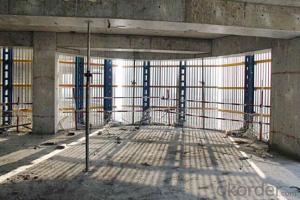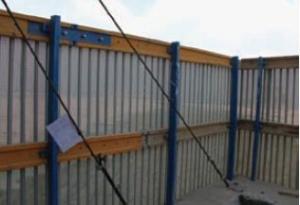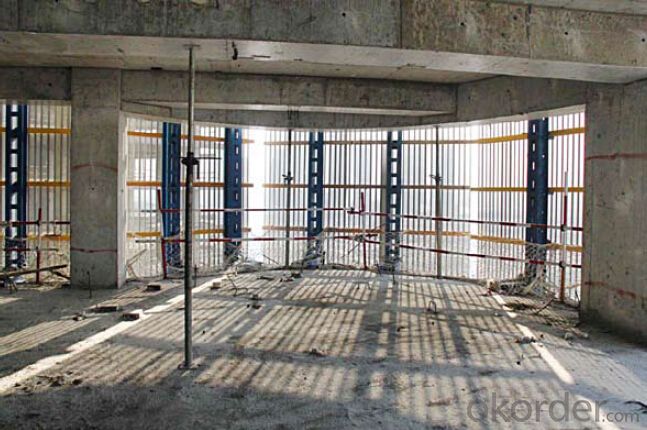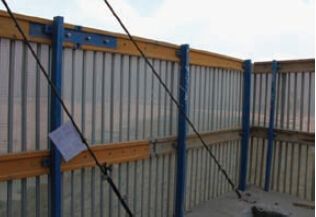Protection-Platform for Formwork and scaffolding system
- Loading Port:
- Tianjin
- Payment Terms:
- TT OR LC
- Min Order Qty:
- 50 m²
- Supply Capability:
- 1000 m²/month
OKorder Service Pledge
OKorder Financial Service
You Might Also Like
Protection Platform PP-50
A kind of new type construction protection system, applying operating platform and safer job
location for construction corps.
Characteristics:
◆ Easy and quick assembling.
◆ Lifted as a group, it is rapid and economic.
◆ Auto-climbing
◆ A safe and reliable anchor system
1. Composition
2. Assembly process of anchor system
(1) Embed V-climbing cone and anchor plate into the slab.
(2) Fix anchor shoe on the slab by tensile bolt.
(3) The fixed anchor shoe.
◆ High work efficiency with work platform and unload platform
◆ High light transmittance with the hollow block


- Q: Can steel formwork be reused?
- Yes, steel formwork can be reused. Steel formwork is a durable and robust material that can withstand multiple uses. It offers a longer lifespan compared to other types of formwork materials such as timber or plywood. One of the main advantages of using steel formwork is its ability to be easily dismantled and reassembled. This allows for the formwork to be reused on different construction projects, reducing the need for new materials and saving costs. Furthermore, steel formwork is resistant to weather conditions and moisture, which contributes to its longevity. It can withstand the pressure exerted by concrete during pouring and curing without warping or deforming, ensuring a consistent and high-quality finish. Additionally, steel formwork can be easily cleaned and maintained, making it suitable for reuse. After each use, the formwork can be cleaned and inspected to ensure it is in good condition for the next project. Any necessary repairs or replacements can be made to ensure its structural integrity. In summary, steel formwork can be reused due to its durability, strength, resistance to weather conditions, and ease of maintenance. Reusing steel formwork not only saves costs but also contributes to sustainable construction practices by reducing waste and conserving resources.
- Q: Can steel formwork be used for underground construction projects?
- Yes, steel formwork can be used for underground construction projects. Steel formwork is a versatile and durable option for constructing various types of structures, including those below ground level. It provides a strong and sturdy support system that can withstand the pressure and loads associated with underground construction. When constructing underground projects such as tunnels, basements, or subways, steel formwork offers numerous advantages. Firstly, it has high load-bearing capacity and structural integrity, making it suitable for withstanding the weight and pressure exerted by the surrounding soil or water. This ensures the safety and stability of the structure being built. Moreover, steel formwork is resistant to corrosion, which is particularly important in underground construction where exposure to water, moisture, and other corrosive elements is common. This resistance to corrosion ensures the longevity and durability of the formwork, minimizing maintenance requirements and increasing the lifespan of the structure. Additionally, steel formwork provides flexibility in design and can be easily customized to meet specific project requirements. It can be fabricated into various shapes and sizes, allowing for the construction of complex underground structures. The modular nature of steel formwork also enables easy assembly, disassembly, and reusability, which can be beneficial for projects that require frequent formwork repositioning. In conclusion, steel formwork is a suitable choice for underground construction projects due to its strength, durability, resistance to corrosion, and flexibility in design. It provides a reliable and efficient solution for constructing underground structures, ensuring their safety and longevity.
- Q: What are the different types of scaffolding used with steel formwork?
- There are several types of scaffolding commonly used with steel formwork, including tube and coupler scaffolding, system scaffolding, and frame scaffolding. Tube and coupler scaffolding consists of steel tubes connected by couplers to form a rigid structure. System scaffolding utilizes pre-engineered components that can be easily assembled, such as modular frames, braces, and platforms. Frame scaffolding involves using vertical frames connected by cross braces and platforms. Each type of scaffolding has its own advantages and is chosen based on factors such as project requirements, ease of assembly, and safety considerations.
- Q: Can steel formwork be used for residential construction projects?
- Residential construction projects can indeed utilize steel formwork. This option, known for its versatility and durability, presents several advantages in the realm of residential construction. It furnishes a solid and steady framework for the pouring of concrete, guaranteeing accurate and uniform shapes for walls, slabs, and other structural elements. Steel formwork proves to be highly reusable, rendering it an economical selection for residential endeavors with multiple concrete pours. It endures numerous uses and can be effortlessly assembled and disassembled, thereby expediting the construction process and reducing labor costs. Furthermore, steel formwork delivers exceptional dimensional stability, ensuring the final structure possesses precise dimensions and smooth finishes. It can withstand the pressure exerted by wet concrete, enabling the construction of high-rise buildings or structures bearing heavy loads. Moreover, steel formwork permits design flexibility, granting architects and builders the ability to fashion unique and intricate shapes within residential edifices. This adaptability renders it suitable for a diverse array of architectural styles and designs. While the initial investment for steel formwork may be higher compared to other formwork materials, its prolonged lifespan and reusability make it an economically viable solution in the long term. It also demands less maintenance and repair when contrasted with traditional timber formwork. In conclusion, steel formwork represents a fitting option for residential construction projects due to its strength, durability, reusability, dimensional stability, and design flexibility. It bestows numerous benefits and aids in the successful completion of top-quality residential structures.
- Q: Can steel formwork be used for architectural concrete beams?
- Indeed, architectural concrete beams can be constructed using steel formwork. The utilization of steel formwork yields numerous benefits in contrast to conventional wooden formwork. These advantages encompass enhanced longevity and the ability to be reused. Steel formwork stands as a sturdier and more inflexible alternative, facilitating the meticulous and precise construction of architectural concrete beams. Furthermore, it delivers a sleek and uniform surface finish, a crucial element in attaining the desired aesthetic appeal of the beams. Moreover, the assembly, disassembly, and transportation of steel formwork can be effortlessly executed, rendering it a pragmatic option for the construction of architectural concrete beams.
- Q: Can steel formwork be used for precast concrete elements?
- Indeed, precast concrete elements can be constructed using steel formwork. The utilization of steel formwork in precast concrete fabrication is widely favored due to its robustness and ability to be reused. It creates a sturdy and inflexible framework capable of withstanding the force exerted by liquid concrete during casting and the load of solidified concrete after curing. Moreover, steel formwork guarantees a uniform and polished appearance for the precast elements, ensuring impeccable and accurate outcomes. Furthermore, the assembly and disassembly of steel formwork is effortless, enabling efficient manufacturing and convenient transportation of precast elements.
- Q: How does steel formwork affect the overall dimensional stability of a structure?
- Steel formwork can significantly enhance the overall dimensional stability of a structure. Due to its strength and rigidity, steel formwork provides excellent support to the concrete during the pouring and curing process. This ensures that the structure maintains its desired shape and dimensions without any significant deformation or dimensional changes. Additionally, steel formwork has minimal expansion and contraction properties, which further contributes to the stability of the structure. Overall, the use of steel formwork helps in achieving accurate and consistent dimensions, resulting in a structurally sound and stable building.
- Q: What are the different types of steel connectors used in steel formwork?
- There are several different types of steel connectors that are commonly used in steel formwork, each serving a specific purpose in ensuring the stability and strength of the structure. Some of the most common types include: 1. Wedge connectors: These connectors are used to secure the form panels together. They feature a wedge-shaped design that allows for easy insertion and tight locking, ensuring a strong connection between panels. 2. Bolt connectors: Bolt connectors are used to join steel formwork components together. These connectors typically consist of a threaded rod and nut, providing a secure and adjustable connection. 3. Pin connectors: Pin connectors are often used to connect steel formwork panels. They consist of a pin and a cotter pin, providing a simple yet effective way to secure the panels in place. 4. Clamp connectors: Clamp connectors are used to hold steel formwork panels together. They typically feature a clamping mechanism that allows for quick and easy installation and removal. 5. Hook connectors: Hook connectors are commonly used to connect steel formwork panels to supporting beams or columns. These connectors feature a hook-shaped design that allows for easy attachment and detachment. 6. Bracket connectors: Bracket connectors are used to provide additional support and stability to steel formwork. They are typically attached to the formwork panels and provide a secure connection to the supporting structure. These are just a few examples of the various types of steel connectors used in steel formwork. The specific type of connector used will depend on the requirements of the project and the formwork design. It is essential to select the appropriate connectors to ensure the safety and structural integrity of the formwork system.
- Q: What are the different types of steel formwork joint solutions?
- There are several types of steel formwork joint solutions used in construction projects. These joint solutions are designed to provide stability, strength, and flexibility to the formwork system. Some of the commonly used types of steel formwork joint solutions include: 1. Butt Joint: This is a simple and commonly used joint where two steel formwork panels are joined together by aligning the edges and securing them with bolts or clamps. Butt joints are easy to assemble and disassemble, making them suitable for various construction applications. 2. Corner Joint: As the name suggests, corner joints are used when two steel formwork panels meet at a corner. These joints are typically formed by overlapping the panels and securing them with bolts or clamps. Corner joints provide stability and reinforcement to the formwork system, particularly in areas where walls or columns are being constructed. 3. T-Joint: T-joints are used when three steel formwork panels meet at one point. This joint solution is formed by overlapping the panels and securing them with bolts or clamps. T-joints are commonly used in construction projects where complex shapes or structures are being built. 4. L-Joint: L-joints are similar to T-joints but involve only two steel formwork panels meeting at right angles. These joints are formed by overlapping the panels and securing them with bolts or clamps. L-joints are used to create corners in formwork systems, such as when constructing columns or beams. 5. Hinged Joint: Hinged joints are used when there is a need for flexibility in the formwork system. These joints allow the formwork panels to pivot or rotate, accommodating changes in shape or position. Hinged joints are commonly used in curved or irregular structures where rigid joints may not be suitable. 6. Adjustable Joint: Adjustable joints are used when there is a requirement for height or width adjustment in the formwork system. These joints allow for easy modification of the formwork dimensions to accommodate changes in design or construction requirements. Adjustable joints are particularly useful in projects that involve varying dimensions or levels. It is important to select the appropriate steel formwork joint solution based on the specific construction requirements and structural design. Proper installation and reinforcement of these joints ensure the stability and integrity of the formwork system, which is crucial for the successful execution of the construction project.
- Q: How does steel formwork handle different concrete testing procedures?
- Steel formwork is a popular choice in the construction industry due to its durability and versatility. When it comes to handling different concrete testing procedures, steel formwork is highly capable and efficient. Firstly, steel formwork can withstand the pressure and weight exerted by concrete during different testing procedures. Whether it is a compression test, slump test, or any other form of concrete testing, the robustness of steel formwork ensures that it remains intact and does not deform under the load. Secondly, steel formwork provides a smooth and even surface for concrete testing. This is crucial for accurate test results, as any irregularities or inconsistencies in the formwork can affect the quality and integrity of the concrete sample being tested. Steel formwork is known for its precision, ensuring that the concrete is poured and shaped precisely as required for each specific testing procedure. Moreover, steel formwork is adaptable and can be easily modified to accommodate various concrete testing procedures. It can be adjusted or reconfigured to meet the specific requirements of different tests, such as creating different shapes, sizes, or depths for concrete samples. This flexibility allows for efficient and accurate testing, as the formwork can be customized according to the testing procedure being carried out. Additionally, steel formwork is reusable, which offers cost-effectiveness and sustainability in concrete testing. Unlike other types of formwork that may need to be discarded after a single use, steel formwork can be dismantled, cleaned, and reused multiple times. This reduces the overall expenses associated with concrete testing procedures and minimizes waste generation, making it an environmentally friendly option. Overall, steel formwork is well-suited to handle different concrete testing procedures due to its strength, precision, adaptability, and reusability. It provides a stable and consistent surface for accurate testing, ensuring reliable results. With its numerous advantages, steel formwork remains a preferred choice in the construction industry for various concrete testing requirements.
Send your message to us
Protection-Platform for Formwork and scaffolding system
- Loading Port:
- Tianjin
- Payment Terms:
- TT OR LC
- Min Order Qty:
- 50 m²
- Supply Capability:
- 1000 m²/month
OKorder Service Pledge
OKorder Financial Service
Similar products
Hot products
Hot Searches
Related keywords



















